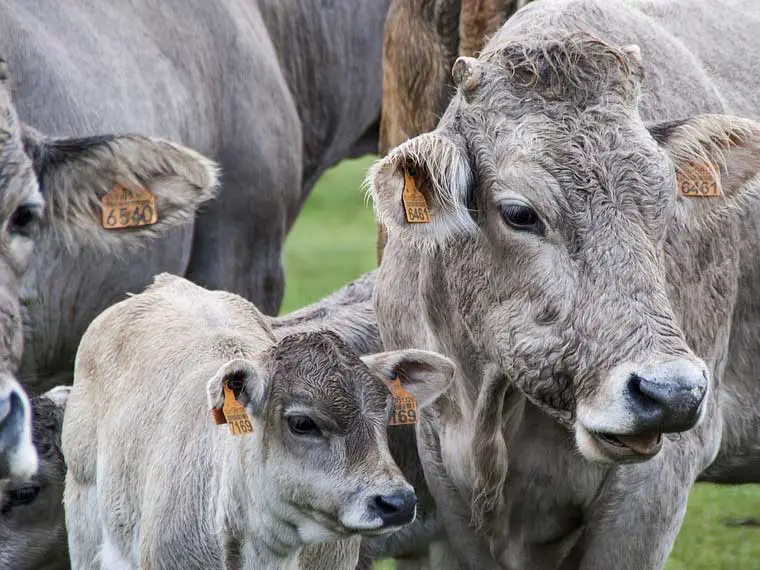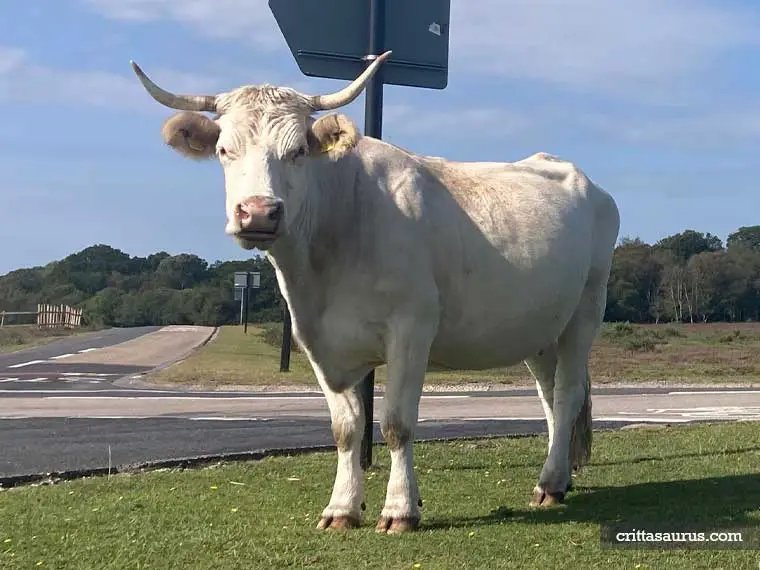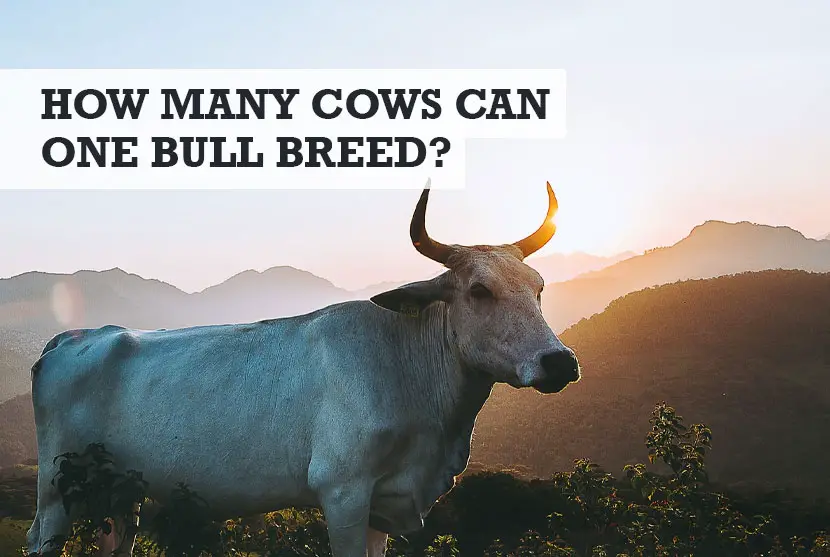Breeding cows comes with many challenges, one of which is how many bulls you might need, or if you only have one bull, then how many cows he can breed and how often. The question over how many cows a bull can handle and impregnate and answered below. I’ve included on what you also need to know if you have multiple cows for breeding in the 25, 50, and 100 range.
Here’s the simple answer first though, but do read on as there are some complexities to it.
How many cows can one bull breed? How many cows a bull can service and breed with depend on the bull’s fertility. A typical mature bull can breed up to 40 cows over 60-90 days. Bulls of 2 years or older that pass a breeding soundness exam can service 30 cows in a 60-70-day breeding season.
If you’re looking to become a professional rancher that works with beef or dairy cows you may wonder how much bull power you need to breed more cows. Read on to find out extensive information about bulls and their breeding power on a ranch.
How many cows can one bull breed?
Whether you want to know how many cows one bull can breed in one month, a year, or breeding specifics around yearling bulls, here’s a detailed breakdown.
Experienced bulls vs inexperienced bulls
Ranchers will need an experienced mature bull to breed. These bulls are two years or older and can mate with up to 30 cows between a 60 and 70-day breeding window. On the other hand, inexperienced bulls that are younger than 2 years can’t service and impregnate as many females.
Younger bulls that are less than 2 years of age should only be introduced to 15 and 20 cows in a 60-to-70-day breeding season.

How many cows can a bull service?
Experts suggest that bulls should service the number of cows according to its age. For example, if the bull is 15 months old it should be able to service 15 cows in a 60 day breeding season.
There is data that shows mature bulls that are 2 years or older can service up to 60 cows in a 70-day breeding season.
Most experts agree that an experienced bull (> 2 years of age) that passes a breeding soundness exam should easily service 30 females in a 60- to 70-day breeding season.
beef-cattle.extension.org
How many cows can a yearling bull breed?
A yearling is an bull that is 1 year old. Experts suggest that bulls that are only a year old should not breed yet. The breeding ability of a bull peaks when he reaches the age of 2 and declines when the bull reaches the age of 5 or 6.
There are few performance tests for young bulls so less is known about their genetics for growth compared to mature bulls. Even if the bull can reproduce at the age of 1 it’s recommended that ranchers wait for the bull to fully mature before allowing it to breed with cows.
As a bull gets older, they have fewer false mounts and higher pregnancy rates compared to younger bulls.
Deciding how many bulls you need
Ranchers will need to know how many bulls they need on their land to reproduce with their cows. The average ranch will need four to six bulls to every 100 cows. However, this will depend on the breeding herd and size of the camps.

For example, on most Virgina farms, ranchers will have a cow to bull ratio of 25:1 for immature bulls and 30:1 for mature bulls. In grazing situations where the paddock size is small a typical mature bull can handle up to 40 to 50 cows.
Let’s break that down into specifics a little more using that cow to bull ratio:
- How many bulls do you need for 100 cows: 4 bulls needed
- How many bulls do you need for 50 cows: 2 bulls needed
- How many bulls do you need for 25 cows: 1 bull needed
It’s not always that simple though. How many cows can a bull inseminate will also depend on the physical attributes of the bull in question. Here’s how that works.
Breeding power of one bull
A single mature bull can breed up to 40 cows during a 60 to 90 breeding period. The bull can sire a high percentage of these cows if the bull has excellent performance. That’s why it’s important for ranchers to purchase bulls carefully.
The bulls must also undergo a breeding soundness exam which involves a systematic evaluation of a bull’s reproductive system. This exam covers the following:
- Examination of the genital organs
- Assessment of sperm production
- Mating ability
- Libido
- Physical performance
It should be noted that the breeding soundness exam doesn’t include a direct evaluation on fertility. You will only know that a bull can successfully breed if he impregnates a fertile female.
The breeding soundness examination (BSE) involves a complete and systematic evaluation of the reproductive potential of a given male, including mating ability and libido, general physical examination and inspection of the genital organs, and assessment of sperm production and quality. The BSE is not a direct evaluation of fertility: this can be confirmed only by successful production of offspring after breeding a fertile female.
MSD Vet Manual, Overview of Breeding Soundness Examination of the Male
Related questions
I hope this has helped you understanding better how many cows can a bull cover, and how many bulls you might need to service all the cows you have. Here are some final tips.
What is the ratio of bulls to cows?
Rotating bulls can help reduce fatigue in your breeders. You can’t expect one bull to impregnant all of your cows. That’s why proper management is needed when breeding calves.
The general rule of thumb is to have 1 mature bull per 30 cows. This is considered the textbook recommended bull to cow ratio.
Therefore, if you have 100 cows you should have at least four bulls on your ranch to service them when the cows go on heat. What’s more, at least a 10 day rest is required between mating.
Handy Hint: Cows are loving creatures and have many different ways of showing affection to their human owners.
How many times can a bull mate in a day?
Active bulls can average up to 20 services per day. Although this activity is not uncommon with mature bulls sometimes this high number of servicing is due to stimulus pressure.
Studies show that bulls with estrus synchronized females, can average up to 55 services per day within a 30-hour observation.
Will a bull mount a pregnant cow?
Cows that are pregnant can still cycle which may cause a bull to mount the cow. Bulls should be separated from cows when they are calving and will be reintroduce to the cows when breeding season starts again. This will prevent bulls from mounting pregnant cows.
How many years can a bull breed?
Bulls can breed cows for as many as 5 to 6 years. The bulls breeding ability usually declines when it reaches 6 years of age.
However, experts suggest that bulls can remain in service between 10 and 12 years of age but this is uncommon. This is why ranchers purchase bulls that are yearlings so they can get as much breeding power out of them as possible.
Ranchers usually purchases yearling bulls with a scrotum circumference of 32 cm. The scrotal circumference determines the maturity of the bull. A bull that’s reached puberty will have a scrotal circumference of 26 cm.
How often can a cow become pregnant?
An average cow can have two to four calves in its lifetime. However, after calving there should be a 50-day rest so that the cow can recover fully before it can breed again.
It’s important for the cow’s reproductive tract to return to normal before it can breed again to prevent complications if it carries another calf.
Furthermore, your vet should palpate the cow’s reproductive tract 30 days after calving to prepare the cow for breeding again. Although bulls can impregnate a high percentage of cows during breeding season, one cow may only be able to have two to four calves in its lifetime .
Conclusion
Ranchers need healthy, fertile bulls to mate with cows in order to reproduce. A bull is one of the most important animals on a ranch and his fertility will impact conception rates.
Additionally, the bull’s genetics will determine calf performance and the weight of the calf.
If you can get the mix right for how many bulls you need for your cows, you should have some great results and healthy calves being born.
You might also like…
- How high a cow can jump is very surprising!
- Do cows have more than one heart?
- What baby cows drink isn’t always what you think… milk?
Image in header via https://unsplash.com/photos/_jdB5skW6W8


